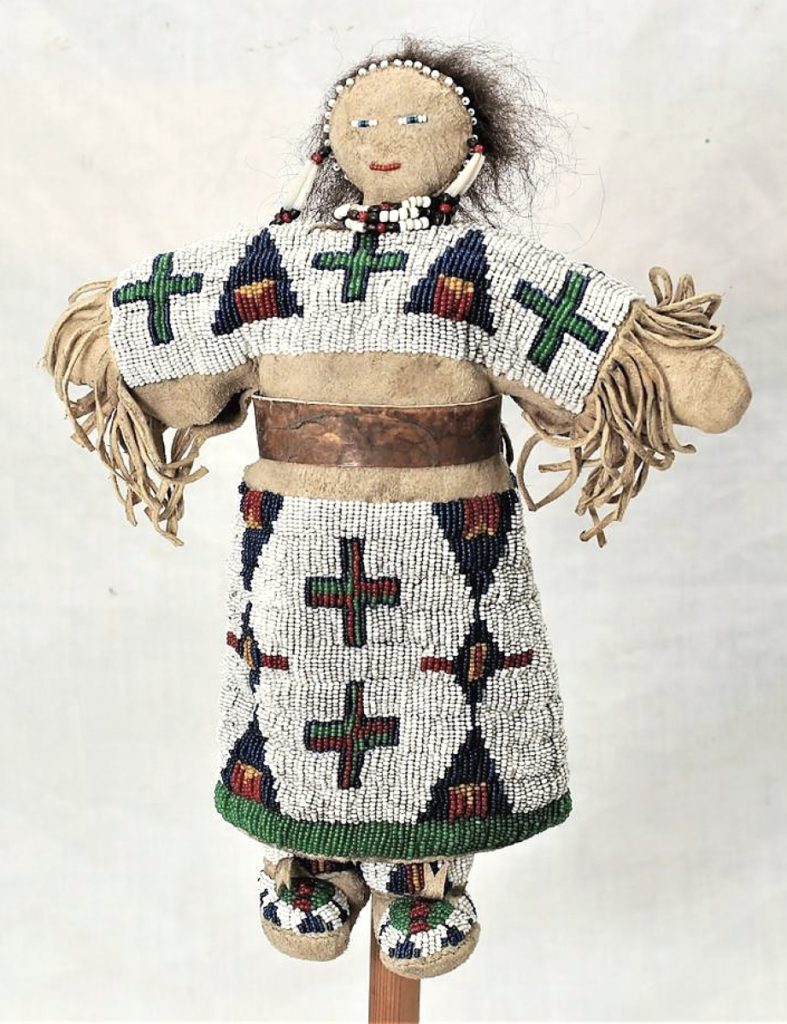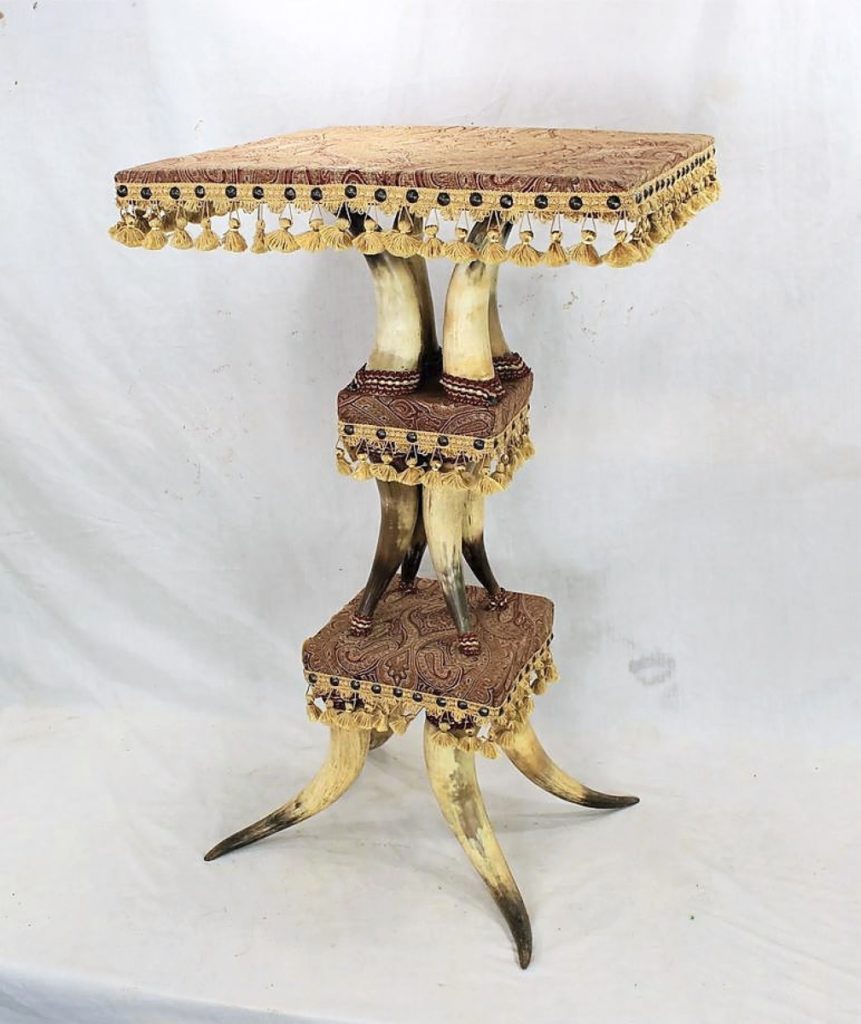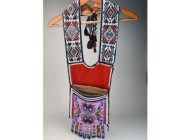
Tools of the trade as art may be epitomized by these early August Buermann spurs. Featuring cutout and chased snake heelbands, they struck a final $5,700 bid ($3,5/5,500).
Review by Marty Steiner, Photos Courtesy New Frontier Western Auctions
CHEYENNE, WYO. – Many Americans have only a bare knowledge of history. What education they do have has come from questionable sources, including books of fiction, magazines and moving pictures. History of the American West has, in part, been based on the Western action movies.
An accurate history of the West can be found in academia but also in the world of collectors. These collectors preserve and illustrate history through the artifacts that form their collections. Sources of these artifacts may be the discovery of long forgotten stashes or family keepsakes, but the most significant sources are auction houses that specialize in Western artifacts.
While many major auction companies occasionally offer this material, the smaller, more focused houses frequently bring their personal interest, knowledge and most of all…their passion to their sales. Scott Tarbell and New Frontier Western Show & Auction are one such. The firm’s most recent auction was on August 27 and was part of their Fall Cheyenne Gun and Western Collectibles Show.
Far and away, the top lot of the sale was a 47-star American flag that had several factors that contributed to its result. Flags with only 47 stars are ones from the year New Mexico became a state and comparatively few were made as Arizona became a state less than two months later. Additionally, this example had flown over the Santa Fe, N.M., capital building. It achieved $24,600.

A young Plains Indian girl would have had this beaded hide dressed doll with real buffalo hair as her companion. It found a new friend for $830 ($1,5/2,500).
It should be noted that this was not a sale with items worth $50,000 and up, but it offered authentic artifacts that are reachable for the collector of more moderate means. Western memorabilia in this sale included cowboy rider equipment such as clothing, chaps, spurs, boots and saddles; horse paraphernalia such as bridles and bits; Native American; weapons such as firearms and knives; and art.
Most western history is built around the American cowboy. This sale offered the real artifacts of that trade rather than the glamourized movie version. The working cowboy’s environment included much time on horseback, so these collectibles include spurs, chaps, cuffs, boots, saddles and other accessories. Spurs have a spiked wheel and worn on a rider’s heel to urge a horse forward; they were the predominant offering of the sale. Chaps (from the Spanish for “legs of iron”) are worn to protect a rider’s legs from hazards while working cattle and other livestock. Leather cuffs were worn to protect their wrists, forearms and shirts from rope burns and brush. Along with boots, whips and saddles, almost all bore some measure of decoration.
Among the most valuable spurs were an August Beurmann pair with cutout snake heel bands that rode to $5,700; a Kelly Bro’s pair for $4,500 that featured double mounted rattlesnakes; and a pair made by Tom Qualey with a shield pattern and scalloped heelbands that finished for $3,960.
Thirteen pairs of chaps offered a wide variety of materials. A pair of G.S. Garcia leather batwing chaps with brass studs forming celestial outline decoration soared to $1,650, ahead of Clark batwings with conchos and stud-formed horseshoes that sold on its $1,200 low estimate. Other chaps included materials. The stars of this group however were two children’s chaps. A pair of bright purple long-haired angora decorated chaps with flower embossed leather belt sold for $1,380, and a 1930s curly white angora version labeled Western’s “Buckaroo Jr,” with cabochon studded leather belt, brought $1,080.

One of three lots of Longhorn furniture, this unique Victorian triple-tiered parlor table will grace a new home for $1,020 ($7-$1,200).
Horse accoutrements sold included bits, headstalls, bridles, riatas (lariats) and a few practical saddles. This was not a sale of the expensive silver encrusted parade saddles and their accessories. Nineteen lots of vintage bits ranged from basic hand wrought iron to decorative show pieces. Sale prices ranged from $240 to $4,200. The top bit lot was for a clearly stamped “Qualey Bros Joseph Ida” Hamley pattern example, which was notable because it was the first Qualey example sold in more than 20 years.
Two headstalls sold for $660 and $1,920. These were an early 1900s Cheyenne fully beaded example and an early Navajo hand worked silver example. These met and exceeded their estimates of $350/550 and $1,2/2,200, respectively. Likewise, two Native American quirts drew strong bids. The first, was fashioned with woven horsehair into a geometric pattern to form the wrist wrap and cover the handle. The thick shaft was hollow and held rattles. The other example, from the 1870s, was fashioned with an image inscribed antler handle, scrimshaw-like. These whipped up $510 and $2,880, both within estimates.
Bridles provide a greater opportunity for the makers’ artistic expression. Created in Montana’s Deerlodge Prison, the top dollar bridle at $3,720 featured woven dyed horsehair geometric patterns, tassels and glass rosettes. Close behind it was a similar Deerlodge example at $3,000. Both met expectations.
Among the unusual items were three lots of furniture formed from longhorns. A three-tiered side table fared the best of the group, topping off at $1,020.
Two trade signs were sold, the top being a boot-shaped cutout tin sign that advertised repairs “While U Wait,” which didn’t linger at $2,280.

Stan Johnson’s 1976 limited edition bronze of a buffalo charging a mounted Indian hunter was marked 13 of 40, mounted on a marble base, and jolted up $2,640 ($800-$1,500).
While this was not a gun sale, 16 lots were sold, including nine handguns and seven long guns. Three handguns led this arsenal with a frame marked “101” for the 101 Ranch, which was founded in 1893 and became one of the largest ranches with more than 110,000 acres. Wild West Shows took place there. The Colt single-action army 45-caliber with finely detailed carved bone grips shot to $8,100, exceeding its target. Another Colt, this an 1871 double action with 3-inch barrel, fully engraved frame and mother-of-pearl grips, hit its bull’s-eye at $5,760, also blowing away its estimate.
This was also not a Western art sale, but six sold bronzes were topped by one made by Stan Johnson in 1976 titled “Buffalo Charging Indian Hunter,” that was on a marble base and earned $2,640. Most bronzes met or exceeded their estimates. Thirteen paintings all sold within estimate.
Native American collectibles come in many forms. Among these are clothing items, weapons and especially decorative items that may have been made specifically for sale, such as rugs and weavings, baskets and pottery. Clothing from top to bottom includes headdress, blouses, pants and chaps, gloves/gauntlets, leggings, footwear and accessories.
The Navajo people – or Diné – are known for their weavings and 13 lots were sold. Sampler rugs were made to display a variety of the geometric patterns that could be produced. An unusually large sampler with nine patterns drew a $5,520 win. A large Storm pattern churned up $1,500 as did a brightly colored Ganado rug.

This reconstructed Santee Sioux hide vest with beaded floral front and geometric back and fringed elements brought $2,130 ($1,6/2,200).
Among the more popular Native American lots were beaded vests and gauntlet gloves. An 1880s fully beaded – both front and back – Plains men’s vest with geometric pattern at $4,320 topped its estimate, with a heavily fringed Santee Sioux version with geometric beaded back panel and floral branches on the hide front going out for $2,130.
A highly unusual Crow child’s buckskin outfit of pants and shirt with matching fringed and beaded cuffs and side seam brought $2,520. Perhaps the same buyer also bought the child’s beaded rawhide doll with buffalo hair for $5,730.
A dozen moccasin examples were sold in this sale. One bidder stepped up to $1,320 to take home a beaded pair of youth sized Sioux ceremonial ones, while a late 1800s Sioux men’s fully beaded pair walked off for $900.
Prices quoted include the buyer’s premium as reported by the auction house. For additional information, 913-406-8057 or www.newfrontiershow.com.




















